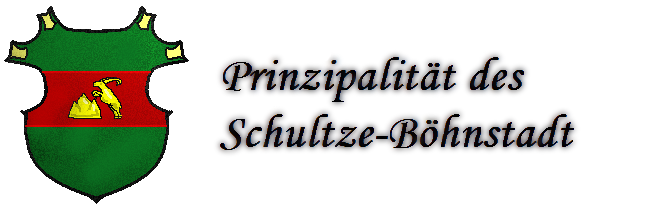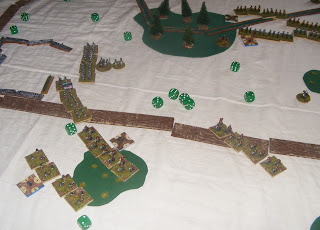At the early stages of the Varangian Wars, although ultimately the war resulted in a draw and the Treaty of Glutemarknog, the Varangian army landed south of the Sjelle Islands, hoping to cleave through the Flossian heartland. It was a harsh November when the Army of Sjelle and a much smaller, but battle-hardened Varangian contingent marched on the small village of Walsund, only a few miles inland; the opposing Union and Böhnstadter armies soon arrived with a large contingent to force them back to the sea.
It was well below freezing point in the morning when the two armies took positions on two edges of the fields south of Walsund. The two lines of battle thus ran south to north. A road ran diagonally to both lines, connecting the village with the continental trading towns. The fields were broken up around the small houses, but were unattended for the coming winter. Walsund had some stone walls surrounding its main square, but otherwise consisted of only a pair of homesteads and a church with whitewashed stone walls.
The field was mostly open ground: three heights, two to the west and one to the east, rose out from the snowy plain. There were dots of woods and swampland throughout, and neither commander was sure these could be passed by the troops. The field's western edge was cut in half by thick woods and a quick stream crossing it. The stream was cold, but not frozen. A walled farmhouse was standing on the far Southern flank, and an inn rose on the eastern height. General Hvalbard Magnusson chose this spot as his HQ, although the ground before the height was the least perfect for defense.
The opposing armies turned out to be almost equal in numbers of troops. The Varangian left comprised of the veterans of the homeland. Four wings of cavalry, including the Life Guards, were posted there, but their commanders saw little opportunity to ride the enemy's flanks down as a large forest also protected the infantry. According to the Varangian tradition, the infantry was arrayed in two lines, and a lighter piece of ordnance was added to the force as a regimental gun.
On the right stood the Army of Sjelle, sporting many captured weapons and uniforms: five battalions of infantry and four wings of cavalry. Only one cavalry unit was Varangian. The islanders' force was commanded by Lukas Verger, and Brigadier General Lars Aldstern of the Gluteborg court was posted there to lead the cavalry. A Glambrian officer, Paul d'Essely, joined General Magnusson's staff, to be later given independent command of the Varangian cavalry on the left.
This arrangement was curious for the onlooker, because while the line of battle, starting on the left, took a traditional form, running northwards to the village its shape changed: in the centre, next to the inn, stood the light infantry contingent and three artillery batteries, and then, instead of a center infantry line, followed the cavalry under General Aldstern.
The Allied army's right, facing the native Varangians, was taken by the Flossian corps, with four units of cavalry including the Hussards Bleus, and four infantry battalions, including a veteran grenadier unit. Then came two units of hussars, as if creating a separate army with infantry in the center and cavalry on the flanks; then the Böhnstadter units, first three squadrons of cavalry, artillery on the northern hill, and the Jäger and line infantry mixed together and huddled up west of Walsund. The Flossian army was led by Elias von Strutzenheim, great-uncle to General Alfred von Strutzenheim (the one leading the Flossian army in the Störkburg Campaign), and the Principality troops had Marshal Eugen von Jazygia, nephew of the Princeps; or rather, would have had, had he not taken to an illness not named here to retain the good general's honour.
At the break of day, the Flossian contingent conducted a daring march against the Varangian left. Their cavalry was checked by the woods and their infantry halted before engaging the enemy. The leading generals were undecisive, knowing the might of a Varangian infantry attack: should they man the farmyard, support the cavalry, or what?
Meanwhile, the cavalry waded to the woods and got tangled up: the Varangian cavalry arm had positioned themselves earlier, and now, instead of charging to the woods and becoming grievously disordered, they waited for the enemy to climb through and fall at them: the Glambrian gentleman was sent there to rally the cavalry and conduct a counter-charge when he saw fit. There was much discord amongst the Flossian arms, an ouverture to disaster.
The Army of Sjelle moved forward in unison, the cavalry momentarily halted by the swampland ahead of them. The ranks quickly reorganized, giving time to the infantry to catch up. The Böhnstadter foot conducted a few oblique movements to deploy south of Walsund: they have obviously chosen a very wrong place to start the day. The islander General Verger saw this clearly, so he did not hurry his troops.
Now a brave and most stupid Flossian colonel decided to rush past the unsupported Varangian infantry's flank, but the swampland north of the main infantry line was teeming with light troops, shooting the massed Flossian infantry up from a distance: these closed the gap, and the rear rank of the regulars' line wheeled, cutting the Flossians off entirely. In the cauldron of fire from grapeshot and musketry, the Flossians surrendered, marking the first casualties of the day.
While the Flossian cavalry negotiated the heavy woods, the Varangian line moved forward and launched a charge against the bogged-down lines. The cavalry followed, looking for the opportunity d'Essely was supposed to perceive. But he had not seen it yet, so this was not the time for the final push.
The light infantry holding the two armies together in the center of the field fought very bravely. They took some casualties, but then the Sjelle cavalry was moved on their right, ready to intercept the Flossian guns on the Böhnstadter extreme flank, and the light troops' morale was quickly restored. The Flossian troops wavered: it was a stalemate of inefficient musketry, sacrificing more and more men. General Strutzenheim was inside the farmyard now, but hesitated to launch neither his cavalry, nor the infantry forward.
The Sjelle cavalry arm was in full sight of the yet uncommitted Böhnstadter cavalry: these were raw Dragoon units, not risking a charge through unknown ground.
The Böhnstadter general now sent the Jäger units forward and two of the grenadier battalions to garrison the village. General Verger only waved at the notion: it was not his goal to engage the enemy in the village: their musketry could harm his infantry line, but his trust was now in the blue and white-coated cavalry.
It was exactly noon and despite the occupying grenadiers, Walsund's church bells rang over the battlefield. General Aldstern, leading his household cavalry at the head of the charge of their islander comrades, rushed straight at the guns stationed on the hill, driving crews off and spiking three. He knew he had enough time to wheel because the Böhnstadter dragoons also had to maneuver before a headlong charge.
Now the agile Böhnstadter light cavalry crossed the brook and the surrounding woods, reappearing in the face of the Varangian light infantry.
General Verger moved his infantry line past the main road, shooting at the Jäger, standing hapless in the open ground, and keeping the village garrison occupied. The fight was prolonged and hours passed. Aldstern's cavalry had to rally, but instead he ordered them to about face and fell at the Jäger, giving the coup de grace.
The Varangian cavalry now charged into the woods and broke the Flossians to the last company. The filed was full of fleeing cavalrymen, but d'Essely refused to pursue. There were still formed Flossian infantrymen ahead, looking eager to fight despite the hardships of the day.
Three past noon. The Böhnstadter hussars cleared the Flossian infantry's flanks of the Varangian light infantry, throwing back one unit and destroying another. This is the first Varangian battalion to break after hours of fighting. The rest is worn, but their fighting spirits are raised. The Flossian infantry hurries to occupy the farm yard before the enemy cavalry could strike: the hussars could not provide any cover against that wall of steel.
Four past noon, the Sjelle infantry is still pouring musketry over the committed Böhnstadt troops. There are very few of them: the main line refuses to march into the chaos. The Grenadiers' way out of Walsund is blocked, so they can't outflank the enemy: their fire becomes ineffective, but General Verger would not charge the walls.
The sun begins setting when the Sjelle cavalry, with one brave dash, hurls itself at the Böhnstadter dragoons. The dragoons made a charge earlier, but not with full force as the unit on the right did not manage to cross the brook. The Allied army's morale is at breaking point, and the spirited Varangian cavalry outflanks a dragoon unit. Overwhelmed and fighting from an uncanny position, the dragoons break and the two halves of the army are severed. The Böhnstadter, having most of their troops still uncommitted, leave the field first; the remaining light cavalry joins the Flossian foot, having to fight in the rearguard to preserve the foot's retreat.
Notes. This was a great presentation: all of my 6mm figures took part in the action. Both armies' morale was set above their actual strength. The Allied army had 17 units and the Varangians 16; the morale was 18 for both. Played as a four-player battle with one extra deck of cards before the Reshuffle card added, it turned up after the second card dealt from its deck. This made a very short, late November day with little light to fight between dawn and dusk. The Varangians had one card of the last deck when making their final charge, and the Allies had one point of morale. The cumulative modifiers (Notable, outflanked, overpowered, having four Disruption) were -12 for the Dragoons being charged, no chance of survival. If the Sjelle cavalry was not positioned so smartly after treading down the Jäger, the battle would have resulted in a draw: indeed, this was what kept the Allied commanders fighting on. Sometimes a general fights to lose a battle gracefully.
The fault, although plenty of advice was given, lay in the setup of the Allied forces. Walsund was not an objective, but a hindrance to an attacker: it is never the attacker's goal to own a defensive position. On the other hand, the Varangians, as their historical predecessors, the Swedish armies of the Great Northern War, despite fighting from a numerical disadvantage and deemed the 'defenders' based on the scouting rolls, moved forward agressively and engaged at every chance. The Allied commanders failed to do this: they were shaky when committing large forces, and heavy-handed when the need to maneuver arose.
What the Allies should have done to ensure victory was to conentrate a lare amount of combined infantry in the centre, and head for the objective, secured on the flanks by the cavalry. A skirmish screen made of combined light infantry and cavalry would have also helped. The Varangian army never suffered grave losses or, indeed, lost a sufficient amount of army morale.
















No comments:
Post a Comment